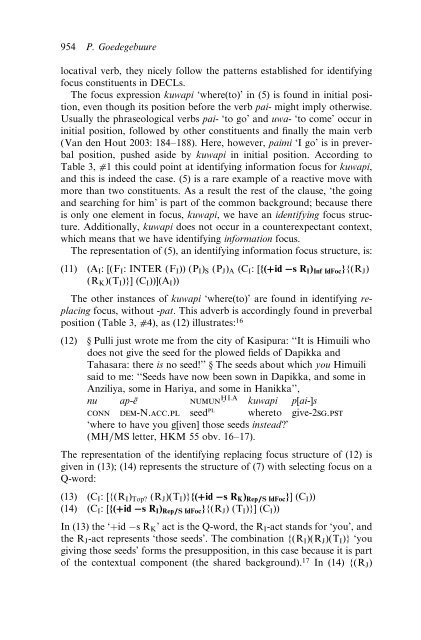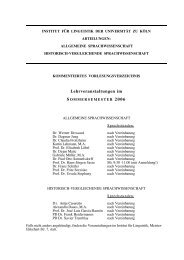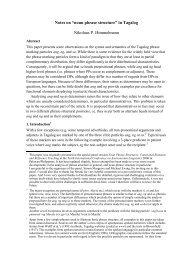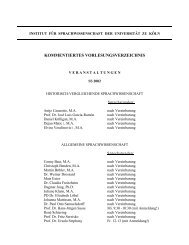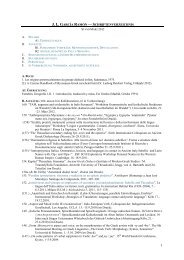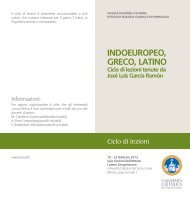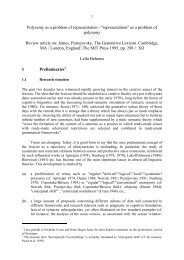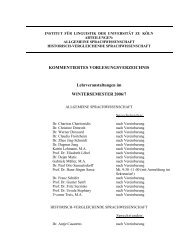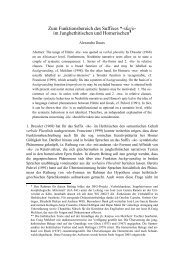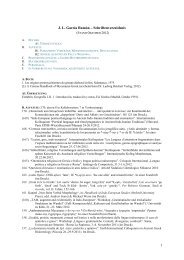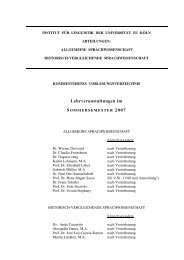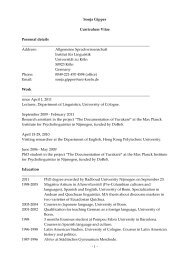Topics in Anatolian Historical Grammar Prof. Dr. H. Craig Melchert
Topics in Anatolian Historical Grammar Prof. Dr. H. Craig Melchert
Topics in Anatolian Historical Grammar Prof. Dr. H. Craig Melchert
You also want an ePaper? Increase the reach of your titles
YUMPU automatically turns print PDFs into web optimized ePapers that Google loves.
954 P. Goedegebuure<br />
locatival verb, they nicely follow the patterns established for identify<strong>in</strong>g<br />
focus constituents <strong>in</strong> DECLs.<br />
The focus expression kuwapi ‘where(to)’ <strong>in</strong> (5) is found <strong>in</strong> <strong>in</strong>itial position,<br />
even though its position before the verb pai- might imply otherwise.<br />
Usually the phraseological verbs pai- ‘to go’ and uwa- ‘to come’ occur <strong>in</strong><br />
<strong>in</strong>itial position, followed by other constituents and f<strong>in</strong>ally the ma<strong>in</strong> verb<br />
(Van den Hout 2003: 184–188). Here, however, paimi ‘I go’ is <strong>in</strong> preverbal<br />
position, pushed aside by kuwapi <strong>in</strong> <strong>in</strong>itial position. Accord<strong>in</strong>g to<br />
Table 3, a1 this could po<strong>in</strong>t at identify<strong>in</strong>g <strong>in</strong>formation focus for kuwapi,<br />
and this is <strong>in</strong>deed the case. (5) is a rare example of a reactive move with<br />
more than two constituents. As a result the rest of the clause, ‘the go<strong>in</strong>g<br />
and search<strong>in</strong>g for him’ is part of the common background; because there<br />
is only one element <strong>in</strong> focus, kuwapi, we have an identify<strong>in</strong>g focus structure.<br />
Additionally, kuwapi does not occur <strong>in</strong> a counterexpectant context,<br />
which means that we have identify<strong>in</strong>g <strong>in</strong>formation focus.<br />
The representation of (5), an identify<strong>in</strong>g <strong>in</strong>formation focus structure, is:<br />
(11) (A I :[(F I : INTER (F I )) (P I ) S (P J ) A (C I :[{(Bid Cs R I ) Inf IdFoc }{(R J )<br />
(R K )(T I )}] (C I ))](A I ))<br />
The other <strong>in</strong>stances of kuwapi ‘where(to)’ are found <strong>in</strong> identify<strong>in</strong>g replac<strong>in</strong>g<br />
focus, without -pat. This adverb is accord<strong>in</strong>gly found <strong>in</strong> preverbal<br />
position (Table 3, a4), as (12) illustrates: 16<br />
(12) § Pulli just wrote me from the city of Kasipura: ‘‘It is Himuili who<br />
does not give the seed for the plowed fields of Dapikka and<br />
Tahasara: there is no seed!’’ § The seeds about which you Himuili<br />
said to me: ‘‘Seeds have now been sown <strong>in</strong> Dapikka, and some <strong>in</strong><br />
Anziliya, some <strong>in</strong> Hariya, and some <strong>in</strong> Hanikka’’,<br />
nu ap-ē numun H˘ I:A kuwapi p[ai-]s<br />
conn dem-N.acc.pl seed pl whereto give-2sg.pst<br />
‘where to have you g[iven] those seeds <strong>in</strong>stead?’<br />
(MH/MS letter, HKM 55 obv. 16–17).<br />
The representation of the identify<strong>in</strong>g replac<strong>in</strong>g focus structure of (12) is<br />
given <strong>in</strong> (13); (14) represents the structure of (7) with select<strong>in</strong>g focus on a<br />
Q-word:<br />
(13) (C I : [{(R I ) Top? (R J )(T I )}{(Bid Cs R K ) Rep/S IdFoc }](C I ))<br />
(14) (C I :[{(Bid Cs R I ) Rep/S IdFoc }{(R J )(T I )}] (C I ))<br />
In (13) the ‘þid sR K ’ act is the Q-word, the R I -act stands for ‘you’, and<br />
the R J -act represents ‘those seeds’. The comb<strong>in</strong>ation {(R I )(R J )(T I )} ‘you<br />
giv<strong>in</strong>g those seeds’ forms the presupposition, <strong>in</strong> this case because it is part<br />
of the contextual component (the shared background). 17 In (14) {(R J )


